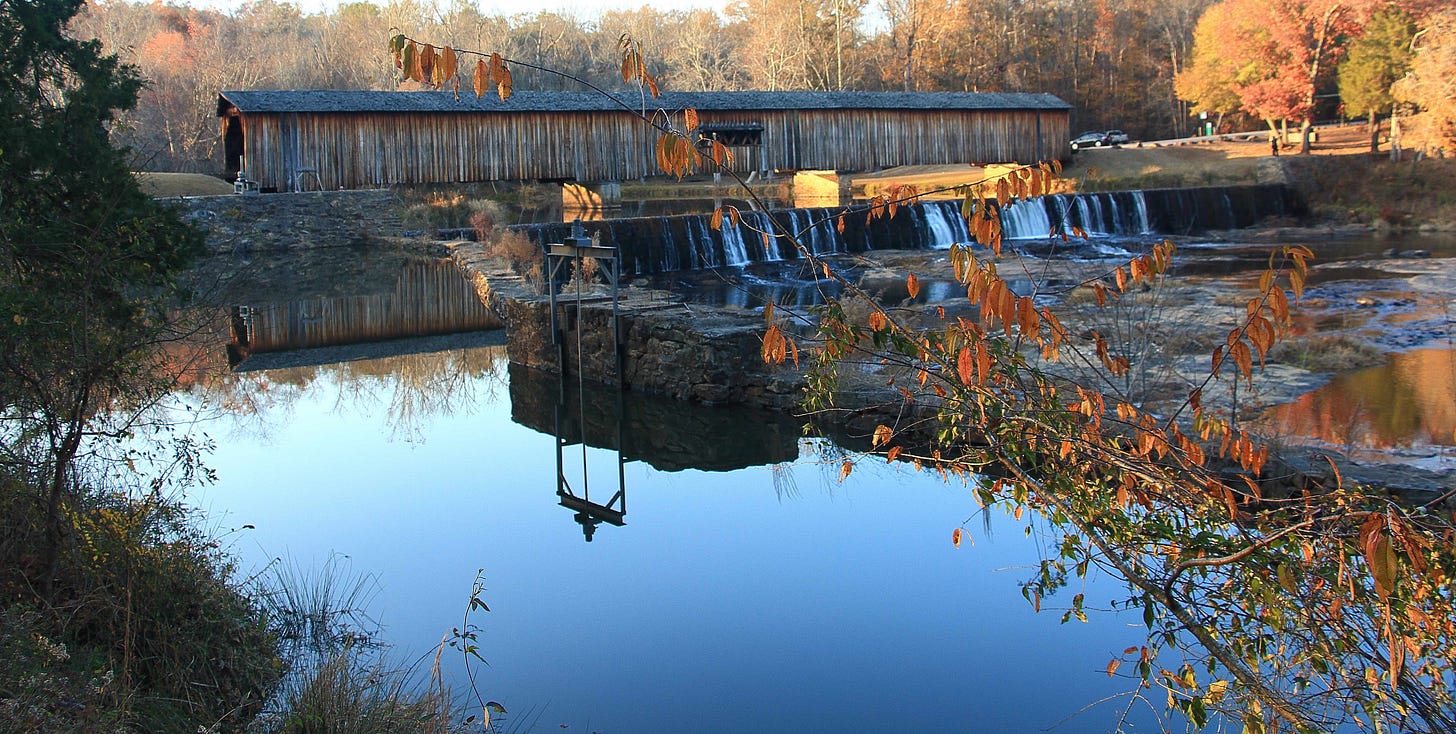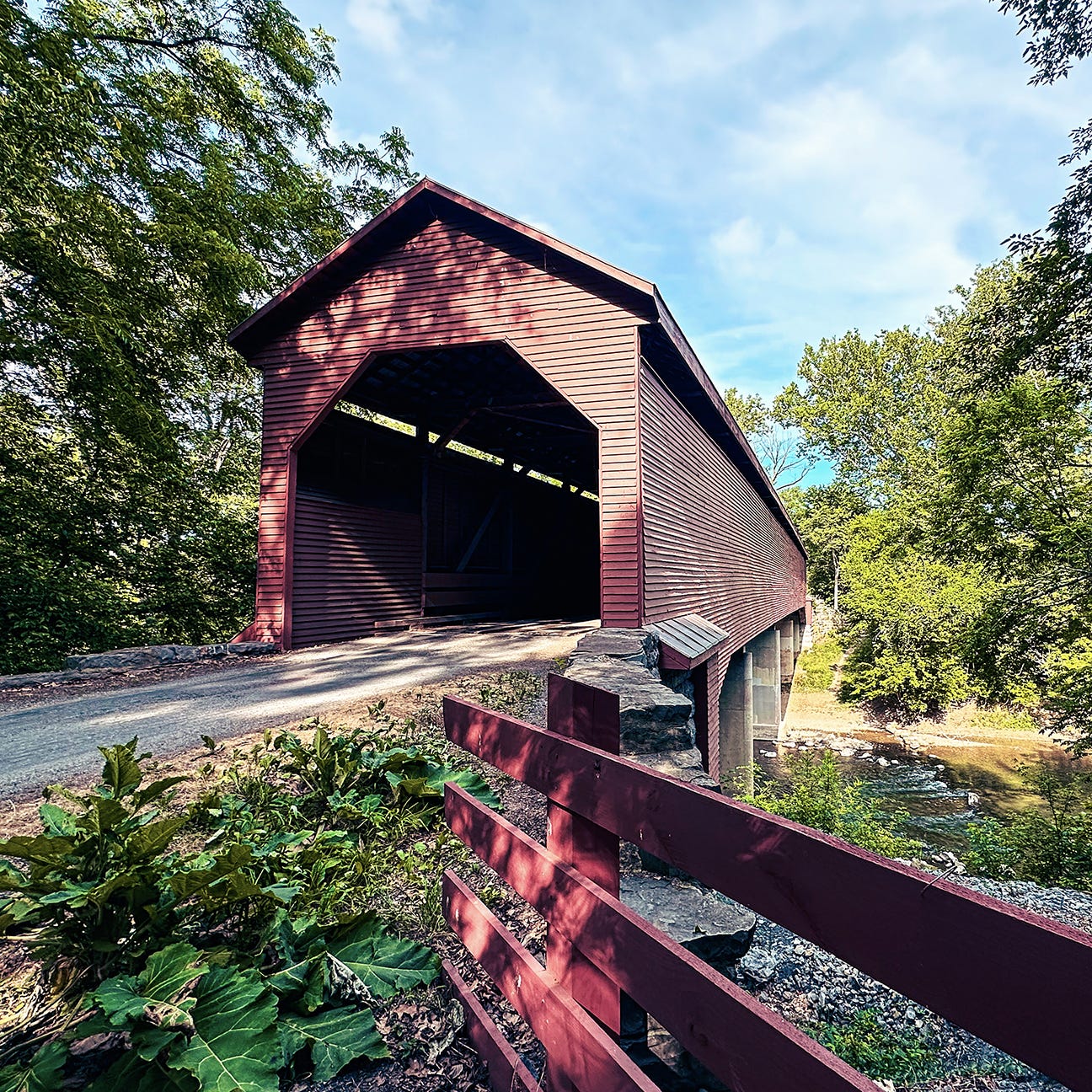Bridge to the Past
The history of the covered bridge is fairly straightforward
Bridge to the Past
By Tom Poland
My mother talked often about covered bridges when I was a boy. She told me how picturesque they were. I write “were,” because in her youth she saw several firsthand. Since then, many have burned. Today’s survivors are relicts, just as gristmills, standpipe water tanks, and smokehouses are.
I saw my first covered bridge in The Bridges of Madison County starring Clint Eastwood and Meryl Streep, but that was on the silver screen—the bridge itself afar, in Winterset, Iowa. That changed one fall afternoon in northern Greenville County, South Carolina. It was late afternoon when sunlight comes in so low everything turns gold and lustrous, but driving is hard. A bit blinded as I rounded a curve, I got a shock as my eyes adjusted. It was the bridge in a Robert Clark photograph, framed and hanging in my house: Campbell’s Covered Bridge.
I walked into the old bridge. Through the wooden flooring, I could see Beaverdam Creek running cold and swift over rocks. Everything was peaceful. I stayed a while thinking about the years when wagons and vintage cars rolled through and no one gave a second thought to the bridge’s uniqueness. Serene, it made for a nice spot for couples. Sure enough, as I walked out, a young couple drove up. I was glad to see the old bridge still had its pull on romantic souls.
Campbell’s Covered Bridge, South Carolina’s last, sits near the town of Gowensville. Greenville County owns the bridge and closed it to traffic in the early 1980s. It joined the National Register of Historic Places July 1, 2009.
Covered Bridges of the South
The history of the covered bridge is fairly straightforward. Early bridges in this country were not much more than logs stretched across timbers over creeks. As bridge construction evolved, builders created longer spans using trusses, arches, and joined stringers. Like most structures early in this country’s history, bridges were almost entirely made of wood. The joints of a wooden truss bridge would rot if exposed to the weather. Building a roof solved that problem, and that blessed our culture with a charming edifice: the covered bridge.
Why not visit a covered bridge? In Meriwether County, Georgia, you’ll find the Red Oak Creek Bridge built in 1840 by freed slave and noted bridge builder, Horace King. At 391 feet including approaches, this structure is the oldest and longest wood-covered bridge still in use in Georgia. All these years later, it’s stout. The “Kissing Bridge,” as it’s known, is open to traffic.
The movie, Lawless, featured it. Sometimes called the Imlac Covered Bridge since it spans Red Oak Creek in the small community of Imlac, the bridge is 4 miles north of Woodbury, just 12 miles north of Warm Springs where President Franklin Delano Roosevelt sought therapy for polio.
Oconee County, Georgia, claims the Elder Mill Covered Bridge. Built in 1897, it was moved to its current location just south of Watkinsville off State Road 15 in the 1920s. The bridge benefitted from restoration during Jimmy Carter’s governorship. The Elder Mill Covered Bridge, one of thirteen functioning covered bridges in Georgia, is the only covered bridge along the Georgia Antebellum Trail. It was placed on the National Register of Historic Places in 1994.
Near Comer, Georgia, not far from the South Carolina state line, the Watson Mill Bridge pulls people back again and again. Washington W. King, son of freed slave and covered bridge builder Horace King, built the 229-foot bridge in 1885, the longest, not including approaches as Red Oak does. Watson Mill Bridge replaced an earlier structure that Gabriel Watson, owner of the original mill here, built near the site of the present bridge. A rising south fork of the Broad River washed the old bridge away. An early owner of the Watson Mill land put up a hydroelectric plant that generated energy from the south fork of the Broad River. That power ran a mill complex, blacksmith shop, store, and hotel. Rural electrification brought an end to the generation of power there.
People drive to Watson Mill Bridge State Park to enjoy the peaceful setting. The bridge and Broad River’s white water create a scene akin to an extraordinary setting in a movie. To see the bridge is to see the past, when roads were narrow and times simpler.
In the Volunteer State the Harrisburg Covered Bridge in Sevierville, Tennessee, spans the Little Pigeon River’s east fork and something else—years of attrition and fallen comrades. The Volunteer State has but six covered bridges left. A tip of the hat to Sevier County. Over the years, the county maintained the bridge as other covered bridges fell to progress. In 1975, the Harrisburg Covered Bridge joined the National Register of Historic Places as a rare covered timber truss bridge. In 1983, the deteriorated bridge faced closure, but the county gave it new flooring and beam replacements, yet again breathing life into this classic survivor. And the classy red survivor speeding out of this one-way time passage? Difficult to identify.
“What made this scene so unusual was the classic red car,” said Robert C. Clark. “I was photographing the bridge interior when I saw this car coming from the other side. I ran to my position and got three shots of the car passing by ... one of those ‘right place at the right time’ moments. What were the odds of all this coming together?”
E.A. Bible had a covered bridge built in Greenville, Tennessee in 1923 so he could cross Little Chuckey Creek to gain better access to Warrensburg Road. A.A. McLean, a noted Tennessee bridge-builder of the day, built it. In 1948, Bible Covered Bridge was deeded to Greene County. In 1975, it became an historical structure through the efforts of the Greene County Heritage Trust. The Greene County Highway Department completed the bridge’s restoration in 2004 with a grant from the Tennessee Department of Transportation.
Historic Pisgah Covered Bridge, one of North Carolina’s two remaining covered bridges, went up in 1911 at a cost of $40. The 54-foot bridge crosses the West Fork Branch of Little River within the Uwharrie National Forest. It brings to mind the county’s past when horse and wagon were common and automobile travel was in its infancy.
Fourth Times a Charm
Meems Bottom Covered Bridge
By Jennifer Linney
Turn west off U.S. Route 11 onto State Route 720 in Virginia’s Shenandoah County, and you’ll find yourself instantly removed from the low-key hustle of the Valley Turnpike. A peaceful, half-mile stretch of a straight country lane passes through a leaf tunnel in spring and summer, courtesy of trees lining both sides. Up ahead—large, yet unassuming—stands Meems Bottom Covered Bridge. It links the floodplain as you traverse through Strathmoor—the farm of late Civil War General Gilbert Simrall Meems—over the north fork of the Shenandoah River to a craggy hill that winds steeply up toward Interstate 81.
The 204-foot truss bridge is the fourth to stand in this place. The first bridge, built in 1867, fell victim to floodwaters in March 1871. Then again, in November 1867, floods wiped out the second bridge, which had been built in 1871. A third bridge, built in 1878, spanned the river until 1894, when the current bridge replaced it. The addition of steel I-beams in 1937 reinforced the bridge, and the original roadway was resurfaced. It stood without incident until 1976, when fire damaged it, causing only charring to the bridge’s structural timbers. Repairs to the frame, roof, and weatherboard after the fire further strengthened the bridge. Local traffic has crossed the bridge daily ever since.
Noted as the longest of Virginia’s few remaining covered bridges, Meems Bottom Covered Bridge features Burr arch-trusses (also called the “king-post arch system”)—two wooden arches spanning the full distance between the bridge’s stone abutments. The abutments, made of rectangular-cut limestone blocks from a local quarry, extend about 10 feet under the riverbed. The bridge’s rough-sawn pine timber was harvested from Strathmoor.
Meems Bottom Covered Bridge earned recognition from the Virginia Landmarks Register in April 1975 and the National Register of Historic Places in June 1975 for its high-quality timber and masonry construction, as well as for its scenic setting. The day I visited, a mom, grandmother, and preschool boy waded and splashed in the waters passing below the bridge.
Source: Virginia Department of Historic Resources
Thanks for reading! We hope you always remember to …
Take the long way home.





